
The Global System for Mobile Communications (GSM) is a standard developed by the European Telecommunications Standards Institute (ETSI) to describe the protocols for second-generation (2G) digital cellular networks used by mobile devices such as mobile phones and tablets. GSM is also a trade mark owned by the GSM Association. GSM may also refer to the Full Rate voice codec.

A ringtone, ring tone or ring is the sound made by a telephone to indicate an incoming call. Originally referring to and made by the electromechanical striking of bells, the term now refers to any sound on any device alerting of a new incoming call—up to and including recordings of original telephone bells.

A cell site, cell phone tower, or cellular base station is a cellular-enabled mobile device site where antennas and electronic communications equipment are placed to create a cell, or adjacent cells, in a cellular network. The raised structure typically supports antenna and one or more sets of transmitter/receivers transceivers, digital signal processors, control electronics, a GPS receiver for timing, primary and backup electrical power sources, and sheltering.
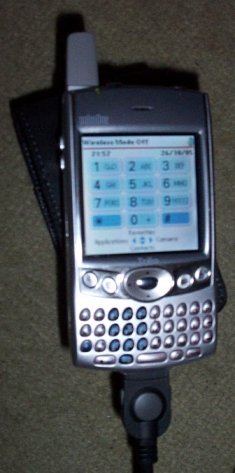
Treo 600 was a smartphone developed by Handspring, and offered under the palmOne brand after the merger of the two companies. Released in November 2003, it has a number of integrated features and it is possible to check the calendar while talking on the phone, dial directly from contacts list, take pictures or send emails. It includes a five-way navigation button and favorites screen allowing quick access to the phone functions.

The Nokia 3510 is a mobile phone for the GSM network, introduced by Nokia on 12 March 2002. The phone was the first Nokia phone to bring GPRS internet services to the mass market. It was also the first Nokia phone to ship with Beatnik's miniBAE engine, allowing for playback of polyphonic ringtones.

The Nokia 3310 is a discontinued GSM mobile phone announced on 1 September 2000, and released in the fourth quarter of the year, replacing the popular Nokia 3210. It sold very well, being one of the most successful phones, with 126 million units sold worldwide, and being one of Nokia's most iconic devices. The phone is still widely acclaimed and has gained a cult status due to its reputation for durability.

Siemens Mobile was a German mobile phone manufacturer and a division of Siemens AG. Siemens sold Siemens Mobile to the Taiwan-based BenQ in 2005, subsequently becoming BenQ-Siemens and succeeded by Gigaset. The last Siemens-branded mobile phones, the AL21, A31 and AF51, were released in November 2005.
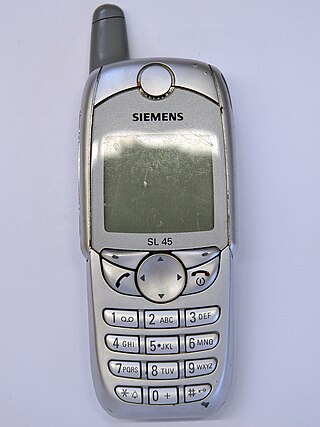
The Siemens SL45 was the first mobile phone with memory expansion and an MP3 player, which debuted in 2001. An improved version, the SL45i, was also the first phone to have a Java virtual machine.
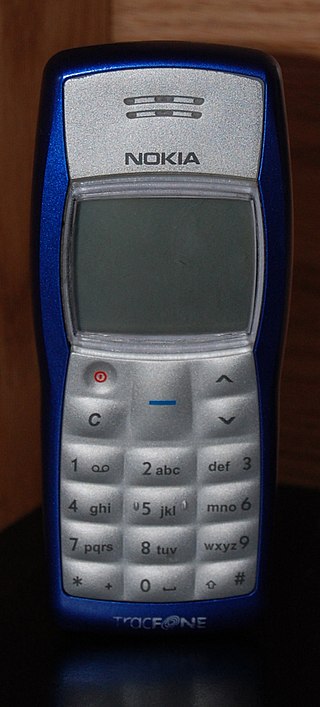
The Nokia 1100 is a basic GSM mobile phone produced by Nokia. Over 250 million 1100s have been sold since its launch in late 2003, making it the world's best selling phone handset and the best selling consumer electronics device in the world at the time. The model was announced on 27 August 2003 and was discontinued in September 2009.

The Nokia 3200 is a mobile phone by Nokia, part of the Nokia Expression (youth) series and announced on 12 September 2003. It is based on the Nokia Series 40 platform. The phone is an update of the Nokia 3100, while adding features from the Nokia 7250i and 6610i. The phone's feature set was very similar to the 7250i and 6610i, but featured different software and firmware installed, and was sold at a lower price than the 7250i or 6610i. Of the three phones, the 3200 was mainly targeted towards the youth market, the 7250i towards fashion-conscious users, and the 6610i towards business users. Core features include an XHTML browser, alarm clock, flashlight, EDGE and FM stereo radio with a 128 × 128 12-bit (4096) color screen. The phone has multimedia features such as picture and text messaging. Features carried over from the Nokia 3100 include ringer profiles and voice memo capability. It also has Java games. The phone has an extensive calendar with a lunar calendar. The flashlight is located under the phone and can be activated by holding the "star" (asterisk) key. The camera is on the back of the phone. The 3200 can also play both polyphonic and monophonic ringtones. The phone's visual interface in its menu system is similar to that of the Nokia 3100, using large, static icons rather than animated ones.

The Motorola Razr is a discontinued series of flip phones that is part of the 4LTR line and was manufactured by Motorola Mobility until 2007, in favor of the Motorola Razr2. The V3 was the first phone shown in the series and was introduced in December 2003 and released in the market in the third quarter of 2004. The V3 model was followed soon thereafter by the improved V3i, including a collaboration with Apple Inc. for iTunes to be built-in. It was launched in 2006.

A mobile phone feature is a capability, service, or application that a mobile phone offers to its users. Mobile phones are often referred to as feature phones, and offer basic telephony. Handsets with more advanced computing ability through the use of native code try to differentiate their own products by implementing additional functions to make them more attractive to consumers. This has led to great innovation in mobile phone development over the past 20 years.

Nokia 8210 is a mobile phone by Nokia, announced on 8 October 1999 in Paris. At the time, it was the smallest, lightest Nokia mobile phone on the market. A primary selling point of its design was its removable cover that allowed for easy customization. Six differently coloured Xpress-on covers are available, as well as many third-party ones.
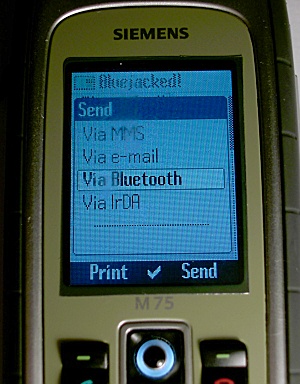
The Siemens M75, this is the successor of Siemens M65. The phone released in 2005, is manufactured by BenQ Mobile. It is one of the few mobile phones to be weather and shock resistant, while not skimping on other features like a 1.3MP digital camera, 262k color screen and a digital music player supporting the MP3 and AAC formats. It comes in 2 color variants, safari green and black.
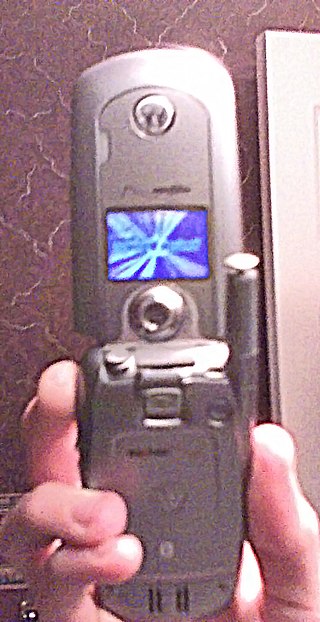
The Motorola E815 is a clamshell mobile phone that is the successor to the V710. It includes the following features:
The Motorola Slvr is a series of mobile phones from Motorola, and is one of the series in the 4LTR line. The first phones were released in early 2005. They are designed to be very thin and lightweight.

The Siemens AX72 is a mobile phone introduced by Siemens in October, 2005. It weighs 79 g and its dimensions are 105,6 x 46,8 x 17,5 mm. Its display a CSTN 65K colors LCD.

A mobile phone is a portable telephone that can make and receive calls over a radio frequency link while the user is moving within a telephone service area, as opposed to a fixed-location phone. The radio frequency link establishes a connection to the switching systems of a mobile phone operator, which provides access to the public switched telephone network (PSTN). Modern mobile telephone services use a cellular network architecture and therefore mobile telephones are called cellphones in North America. In addition to telephony, digital mobile phones support a variety of other services, such as text messaging, multimedia messagIng, email, Internet access, short-range wireless communications, satellite access, business applications, video games and digital photography. Mobile phones offering only basic capabilities are known as feature phones; mobile phones which offer greatly advanced computing capabilities are referred to as smartphones.

The Siemens SL55 is a slider mobile phone released by Siemens in 2003. The phone has a sliding design, and features a WAP browser, Java support and T9 predictive typing. Camera functionality can be added by connecting the clip-on cam. The colours it was available in were ruby and titan. The Siemens SL56, is a variant of the SL55 designed for the American market. Unlike the SL55, the SL56 is a dualband phone.


















